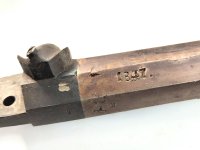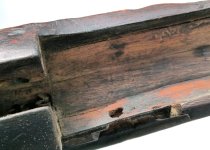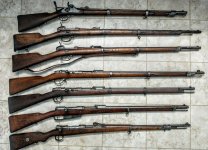Here's a nice throwback to the pre-unification era that I picked up back in 2022.
I have a fairly diverse Jägerbüchse collection ranging from flintlock to Gew98s and this one checked a big box for me. Many thanks to @Spartaner545 (Vincent) for helping me find German language resources on Prussian black powder weapons and for his wonderful assistance in identifying the various traits on this rifle. The Jägerbüchse were originally rifled muzzle loaders that used a patched bullet to achieve significant accuracy compared with smoothbore muskets. They were used to great effect in several conflicts in the 17 and early 1800s by a number of German states. In a case of imitation being the most sincere form of flattery, the British later followed suit with the Baker rifle.
In any case, there are a few features that identify this as a Jägerbüchse 1811 UM, rather than the 1835 model-- first is that the nosecap is the original, long version (this was changed in the 1820s to a short one)-- secondly the rear sling swivel is the older, rounded type. The patchbox in the buttstock has two holes in the interior for storing spare nipples (an easily broken part). The ramrod is unfortunately not original to the rifle.
The unit marking (1820s or 30s era), which appears on the buttplate (and partially underneath the barrel!) is 2C 2JA 78" reads as the "2nd Company, 2nd Jäger-Abteilung, weapon nr. 78.
Another interesting fact that was shared with me is that this example was reworked with a Patentschwanzschraube (Patented end-of-barrel screw), a unit that the barrel was threaded into (and the very end of the barrel removed to accomodate it, this removing the original year of production and FW cypher) This was done to some, but not all of the reworked Jäger rfiles.
Finally, there is a an L.B. marking on the left side of the stock. I am told that the Prussians inspected all weapons in 1852 to assess their condition and usefulness. They were rated on one of the following scales per Vincent :
1) "ready for field use" => no markings
2) "ready for Defence duties with rear line units" => marked D
3) "ready for general armament of the nation in case of an all out war" (germ. Landes-Bewaffnung) => marked L.B.
4) "still usable for training, drill and exercise" => marked E
5) "unusable" (germ. Ausschuss) => marked A
So this example was set aside for a national emergency-- the Hirschfanger bayonet lug was likely ground off during this inspection.
Finally, this one appears to have been sold off to the US either as a Civil War era purchase by the Union, or a postwar commercial purchase. It appears the lockplate was later rustblued, but the rifle remains largely original and unbuggered. There is some information on these rifles sold in America in the book " European Arms in the Civil War" by Schwalm and Hofmann.
In any case, I thought it would be an interesting sidebar for those interested in Prussian Jägerbüchse
Here are the pics.


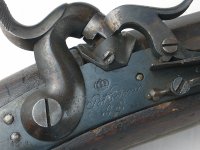
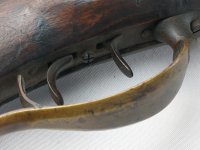
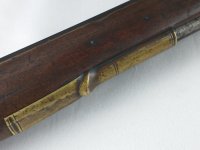

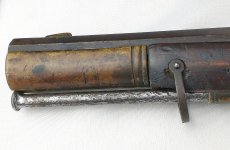

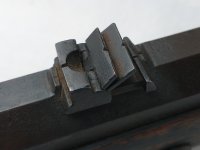

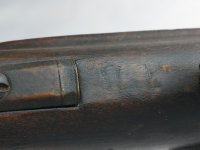
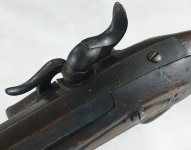

I have a fairly diverse Jägerbüchse collection ranging from flintlock to Gew98s and this one checked a big box for me. Many thanks to @Spartaner545 (Vincent) for helping me find German language resources on Prussian black powder weapons and for his wonderful assistance in identifying the various traits on this rifle. The Jägerbüchse were originally rifled muzzle loaders that used a patched bullet to achieve significant accuracy compared with smoothbore muskets. They were used to great effect in several conflicts in the 17 and early 1800s by a number of German states. In a case of imitation being the most sincere form of flattery, the British later followed suit with the Baker rifle.
In any case, there are a few features that identify this as a Jägerbüchse 1811 UM, rather than the 1835 model-- first is that the nosecap is the original, long version (this was changed in the 1820s to a short one)-- secondly the rear sling swivel is the older, rounded type. The patchbox in the buttstock has two holes in the interior for storing spare nipples (an easily broken part). The ramrod is unfortunately not original to the rifle.
The unit marking (1820s or 30s era), which appears on the buttplate (and partially underneath the barrel!) is 2C 2JA 78" reads as the "2nd Company, 2nd Jäger-Abteilung, weapon nr. 78.
Another interesting fact that was shared with me is that this example was reworked with a Patentschwanzschraube (Patented end-of-barrel screw), a unit that the barrel was threaded into (and the very end of the barrel removed to accomodate it, this removing the original year of production and FW cypher) This was done to some, but not all of the reworked Jäger rfiles.
Finally, there is a an L.B. marking on the left side of the stock. I am told that the Prussians inspected all weapons in 1852 to assess their condition and usefulness. They were rated on one of the following scales per Vincent :
1) "ready for field use" => no markings
2) "ready for Defence duties with rear line units" => marked D
3) "ready for general armament of the nation in case of an all out war" (germ. Landes-Bewaffnung) => marked L.B.
4) "still usable for training, drill and exercise" => marked E
5) "unusable" (germ. Ausschuss) => marked A
So this example was set aside for a national emergency-- the Hirschfanger bayonet lug was likely ground off during this inspection.
Finally, this one appears to have been sold off to the US either as a Civil War era purchase by the Union, or a postwar commercial purchase. It appears the lockplate was later rustblued, but the rifle remains largely original and unbuggered. There is some information on these rifles sold in America in the book " European Arms in the Civil War" by Schwalm and Hofmann.
In any case, I thought it would be an interesting sidebar for those interested in Prussian Jägerbüchse
Here are the pics.

















